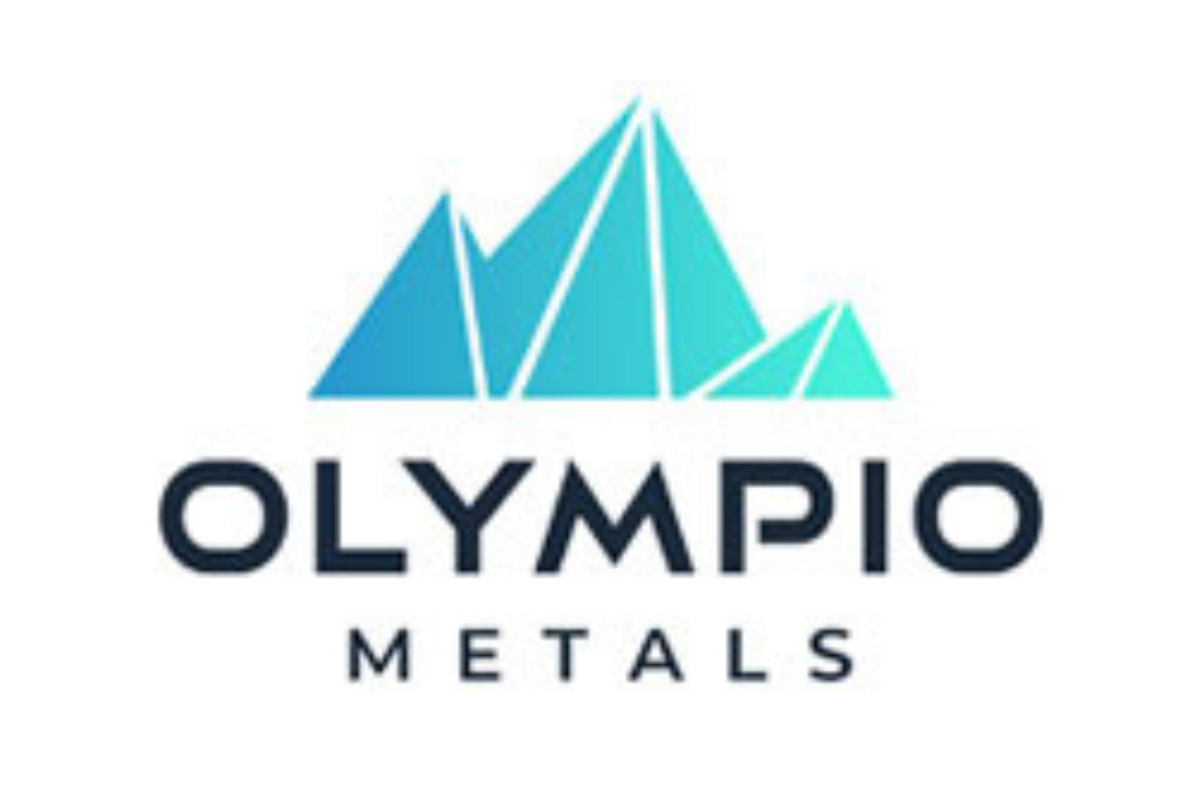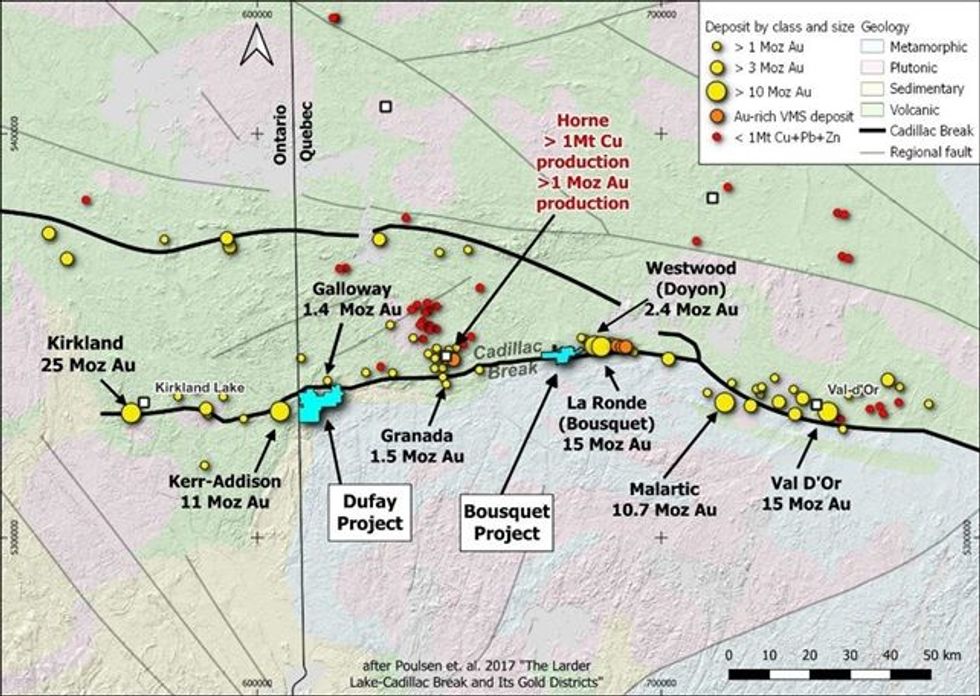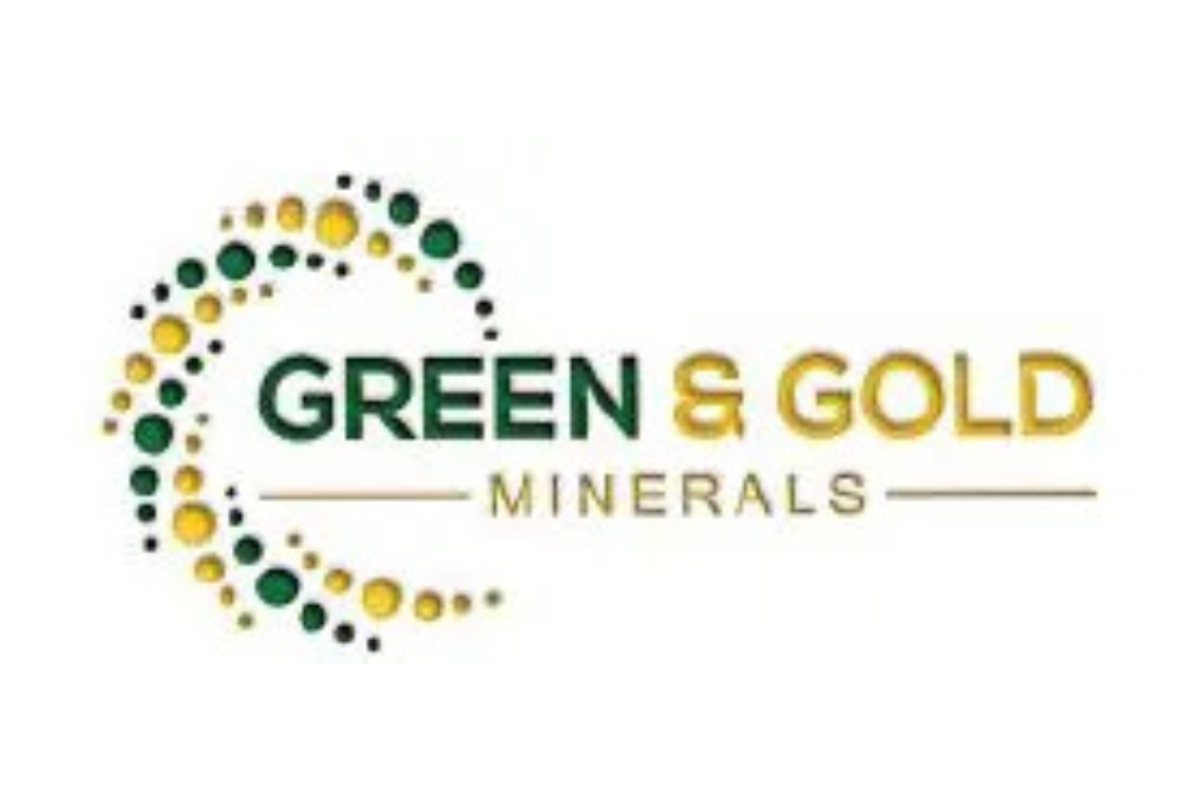
February 25, 2025
Olympio Metals Limited (ASX:OLY) (Olympio or the Company) is pleased to announce that it has signed a binding Letter of Intent with Bullion Gold Resources Corporation (TSX-V:BGD) to enter into an option to acquire up to 80% of the Bousquet Gold Project (Bousquet Option), an advanced high- grade gold project on the Cadillac-Lake Larder Fault Zone, known as the ‘Cadillac Break’ in Quebec, Canada. This terrane bounding structure is associated with world class orogenic gold and copper mineralisation1. The Bousquet Project is located 30km east of the Rouyn-Noranda Au-Cu mining centre (Horne and Granada mines) and 15km west of the Bousquet Mining Camp, which includes the>15Moz Au La Ronde2 and 2.4 Moz Au Westwood3 working mines (Figure 1).
Highlights
- Option to acquire up to 80% of the Bousquet Gold Project from Bullion Gold
- Located on the Cadillac Break, a regional structure associated with world class gold and copper mineralisation (>110 Moz Au1)
- Numerous high-grade prospects including Paquin East with historical intercept of 9m @ 16.96g/t Au6
- Within 15km of multi-million ounce working gold mines (Agnico Eagle’s La Ronde - 15.8Moz Au2 and Iamgold’s Westwood - 2.4Moz Au3)
- High-grade, quartz hosted vein systems with common visible gold, similar to nearby O’Brien Project 15km to the east (1.0Moz Au4, Radisson)
- 24km2 of contiguous tenure, covering a 10km strike of the Cadillac Break
- Complements the Company’s Dufay Au-Cu Project 60km to the west, and provides a combined 20km strike exposure to highly prospective segments of the Cadillac Break
- Excellent road, rail and hydroelectric infrastructure runs through the project, with year- round access
- Underexplored property with the majority of drillholes completed pre-1947
- The Option provides further exposure to a strong gold price with flexible structure terms
Olympio’s Managing Director, Sean Delaney, commented:
“Acquiring the advanced Bousquet Gold Project presents a significant opportunity for Olympio to expand our exposure to one of the world’s premier gold-bearing structures—the renowned Cadillac Break. The project is strategically positioned between substantial gold deposits to the east and west, with numerous high-grade gold prospects featuring gold both at surface and in drilling. This makes Bousquet an exceptional exploration target. The geological setting and mineralisation style closely resemble the nearby million-ounce O’Brien Project, where high-grade gold zones are often associated with visible gold in quartz veining.
“The Project is next to working gold mines with under-utilised mills (<20km by road), with a major highway, railway and hydroelectric power all traversing the centre of the project.
Bullion are divesting Bousquet to focus on their large Bodo polymetallic project which provides Olympio with this great opportunity to explore in one of the world’s best gold regions.”

The Bousquet Gold Project is a strategic land acquisition which complements the Dufay Gold-Copper Project 60km to the west along the renowned Cadillac Break. The southern half of the project covers a well-defined, regionally mineralised zone to the south of the Cadillac Break, which hosts numerous gold prospects within Timiskaming Group sediments that are exclusively correlated with the development of the Cadillac Break.
The Bousquet Project includes several advanced gold prospects and numerous structural and geophysical targets that remain untested by drilling or modern exploration. The majority of drilling on the project is pre-1947, and all prospects remain under-explored.
HIGH GRADE QUARTZ VEINS IN FAVOURABLE GEOLOGICAL CONTEXT
Gold mineralisation at Bousquet is structurally controlled, quartz vein-hosted, high-grade gold associated with second and third order structures peripheral to the Cadillac Break, which is typical of the majority of mineralisation on the Cadillac Break1.
Click here for the full ASX Release
This article includes content from Olympio Metals Limited, licensed for the purpose of publishing on Investing News Australia. This article does not constitute financial product advice. It is your responsibility to perform proper due diligence before acting upon any information provided here. Please refer to our full disclaimer here.
The Conversation (0)
21h
High grade drill results extend gold mineralisation at Mt Wandoo
Green & Gold Minerals Limited (ASX:GG1) is pleased to announce final gold results from the recent Wandoo drill program at the Chillagoe Gold Project. The Mt Wandoo and Little Wandoo prospects are located within granted mining leases with mineralisation commencing at surface. The Company is... Keep Reading...
21h
Drilling Progresses at the Wagyu Gold Project, Pilbara WA
New Age Exploration (ASX: NAE) (NAE or the Company) is pleased to report that the Reverse Circulation (RC) Drill Program is progressing positively at the Wagyu Gold Project (Figure 1). A total of 1,896 m has been drilled so far over 20 drill holes, with an average depth of 95m. The program is... Keep Reading...
12 December
Top 5 Canadian Mining Stocks This Week: Sirios Resources Gains 120 Percent
Welcome to the Investing News Network's weekly look at the best-performing Canadian mining stocks on the TSX, TSXV and CSE, starting with a round-up of Canadian and US news impacting the resource sector.The Bank of Canada Governing Council met on Wednesday (December 10) for the final... Keep Reading...
12 December
Transition Metal
Transition Metals Corp. (TSXV: XTM) is a Canadian-based, multi-commodity explorer. Its award-winning team of geoscientists has extensive exploration experience which actively develops and tests new ideas for discovering mineralization in places that others have not looked, often allowing the... Keep Reading...
12 December
Marmota Unveils High-grade Gold Finds at Greenewood Discovery
Marmota (ASX:MEU) has revealed the first detailed assays from its maiden program at the Greenewood gold discovery in the Gawler Craton of South Australia.In a Thursday (December 11) release, the company highlighted results including 95 grams per tonne (g/t) gold from 22 metres (as part of a... Keep Reading...
11 December
Brixton Metals Closes Tranche 2 Of Its Private Placement
Not for distribution to United States Newswire Services or for dissemination in the United States Brixton Metals Corporation (TSX-V: BBB, OTCQB: BBBXF) (the " Company " or " Brixton ") is pleased to announce that it completed on December 11, 2025, the second tranche of a non-brokered private... Keep Reading...
Latest News
Latest Press Releases
Related News
TOP STOCKS
American Battery4.030.24
Aion Therapeutic0.10-0.01
Cybin Corp2.140.00





